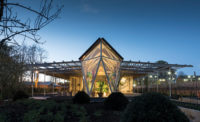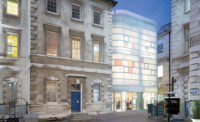Shrewton, England
Visiting Stonehenge in 1829, the photographer William Henry Fox Talbot was dismayed to find the scene “wholly destroyed” by five carriages and 30 picnicking sightseers. Things were to get much worse. By the 21st century, the attraction drew a million visitors a year, who were corralled within close sight of parked tour buses and heavy traffic on two public roads passing north and south of the stone circle.
When DCM was appointed in 2009, it already had substantial experience with the site's sensitivities, having won an earlier competition for a subterranean visitor center, which was canceled along with a related road tunnel that was deemed too expensive. The firm's second take on the project applies a very different approach: instead of digging into the earth, the 17,000-square-foot building sits lightly on it and echoes the gentle folds of the landscape.
A forest of slender, raking columns lifts an undulating roof over three visibly separate pavilions. An outward-looking glass-walled box contains a café, shop, and classroom, while an inward-looking pod clad in weathered sweet chestnut houses an interpretive exhibition created by Leicester-based Haley Sharpe Design. Between them is a smaller zinc-clad ticket booth. The disaggregated composition subtly prefigures the permeable character of the stone circle, and keeps the landscape in view. As they approach the building, visitors can see the hilly horizon through the gap between the pavilions and the roof.
DCM partner Barrie Marshall made his first sketches before the final site had been selected, and took inspiration from one of the alternative locations, a lightly wooded spot closer to the stones. Airman's Corner is more exposed, but new planting will allow the center to be seen in its intended arboreal context and further soften the distinction between building and topography. The allusion is already apparent: the 211 close-spaced steel columns resemble a stand of saplings, and perforated patterns in the blade-like eaves allow sunlight to dapple the limestone pavement below, as if through a leafy canopy.
Because the building sits in a slight depression, it is not visible from the stones. Nevertheless, its size has been rigorously constrained so as not to detract from the experience of the monument. The tallest standing stones determined its maximum height, and although early calculations showed that the program required a building 330 feet long, this was reduced to 255 feet by removing mechanical equipment and offices to a discreet chestnut-clad structure nearby.
The generous amount of space given to on-site treatment of water and waste was the product of another of the project's central concerns: to tread lightly on the archaeologically rich site. To eliminate the need to dig trenches for utilities connections, the building uses water collected from the roof to flush toilets or drawn from the aquifier for drinking and underfloor heating. A shallow concrete raft foundation can be removed without trace at the end of the building's life.
The architects further lightened the project's environmental footprint by using geothermal heating and mixed-mode ventilation, and by limiting the amount of tempered internal space. External circulation, exposed to wind and rain, is also consistent with the outdoor experience of Stonehenge says Stephen Quinlan, director of DCM's UK office. It means that visitors can choose the order in which they visit the facilities, or skip them altogether. The decision not to impose a prescribed route also had a practical purpose: two-thirds of visitors arrive in tour buses, often in convoy, and “anything that worked like a normal building would have difficulty catering for that mass arrival,” says Quinlan.
The slightly skewed placement of the pods is one measure undermining any impression of sterile rationalism, and details such as irregular timber “teeth” around windows in the chestnut pavilion show a playful quality. Children enjoy twirling around the eccentric columns.
The project's success is evident both in the fact that the site is busier than ever—visitor numbers are up by a fifth, and the duration of the average visit has doubled—and in the feeling that it is more orderly and dignified. Much of the harm suffered by Stonehenge over time has resulted from heavy-handed treatment by archaeologists, public authorities, and landowners claiming special responsibility for its protection. Denton Corker Marshall's lightweight, lighthearted building shows what can be done with a lighter touch.
Architecture Today.
People
Owner:
Architect:
Personnel in architect's firm who should receive special credit:
Interior designer:
Engineers:
Consultant(s):
General contractor:
Photographer(s): Size: 17,000 square feet Construction cost: $21 million Project cost: $45.4 million Completion date: December 2013 |
Products
Structural system
Steel frame and columns
Exterior cladding
Metal/glass curtain wall:
Wood:
Moisture barrier:
Roofing
Metal:
Interior finishes
Paneling:
Furnishings
Energy
|












Post a comment to this article
Report Abusive Comment